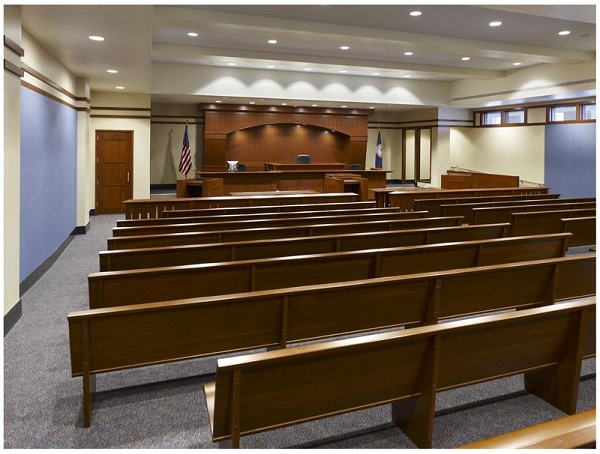Traffic and Arraignment Courts
 |
Fairfax County, Virginia Traffic Court |
Traffic/arraignment courts require a standard non-jury courtroom with special attention to the public and clerical areas. Traffic court is a high-volume operation, and the courtroom must accommodate a large number of persons daily. Most cases are disposed of by pleas, and trials are generally brief with few witnesses and little testimony. A court reporter is usually not present, but the proceedings are often electronically recorded. Most defendants pay or make arrangements to pay their fine before leaving the courthouse, and the clerk should have the facilities adjacent to the courtroom to receive fine payments, issue receipts, and maintain cash.
The arraignment courtroom's primary function is to hold hearings where the defendants hear their rights, hear the charges against them, and enter a plea of guilty or not guilty. The arraignment hearing may also be used to set bail or conditions of release, or to set a date for the preliminary hearing or trial. If the facilities are used after regular court hours, they should be clustered near the entrance to the courthouse, so that the rest of the courthouse may be closed off to the public. The cashier's station should be secured and equipped with controlled access and a screened payment counter. Direct access from the courtroom to the cashier counter should be provided for litigants making payments before their release.
Traffic court may be the only contact that most people have with the judicial system. It is important that the courtroom project a suitably dignified judicial image.
A special seating section should be designated for police witnesses. This may be located to the side of the courtroom. The courtroom should hold no more than 100 to 150 people and the maximum size should be between 2,000-2,400 square feet. A too large, or overcrowded, courtroom reduces the dignity of the court and is difficult to control. If needed, additional public seating should be provided in the public waiting area outside the courtroom, or the court should consider changing its case calendaring system.
Because of the large number of people, air ventilation is important, and special attention may need to be given to room acoustics.
Same as for trial courtrooms.
The location of the traffic/arraignment courtroom should be close to the court's main public entrance, preferably on the ground floor, so that the entire building does not need to be secured if court is held after hours. The courtroom should have a separate exit to the cashier's window.
This courtroom accommodates higher traffic volumes and circulation than general trial courtrooms, and special attention needs to be paid to circulation in the spectator seating areas. Sufficient public seating should be provided adjacent to the courtroom, and restroom facilities should be nearby.
In most situations, the witness stand will be entered through the litigation area from the spectator-seating area. When not testifying, witnesses in controversial or emotional trials may be isolated, or excluded from the courtroom, in victim/witness rooms adjacent to the courtroom.
A holding area next to the courtroom is necessary. It must be remembered that in -custody defendants, including felons, often appear in traffic or arraignment courtrooms and the same security requirements exist as for regular criminal courtrooms.
Bench or pew-type seating in the spectator area is recommended to accommodate a large number of people.
In most courtrooms, judges and court staff should have access to audiovisual/video equipment, computer terminals or personal computers, and automated case management systems. Technology closets should be positioned adjacent to the courtrooms for audio/visual racks and other computer technology.
Sound and video equipment. While most courts‑of-record will probably continue to use court reporters for taking the record, electronic audio and video recording and playback equipment should be available in every courtroom to present evidence and record the proceedings. Microphones should be controlled by the judge or clerk and located at the bench, witness stand, podium, attorney tables, and interpreter's stand.
Sound amplification systems. All courtrooms greater than 800 square feet should be equipped with sound amplification equipment for the hearing impaired. The equipment also permits the playback of audio exhibits. Master controls should be located at the bench or court clerk's station. Access to computer terminals and video display monitors should be planned for the bench, court clerk's station, court reporter's station, attorney tables, witness stand, and jury box.